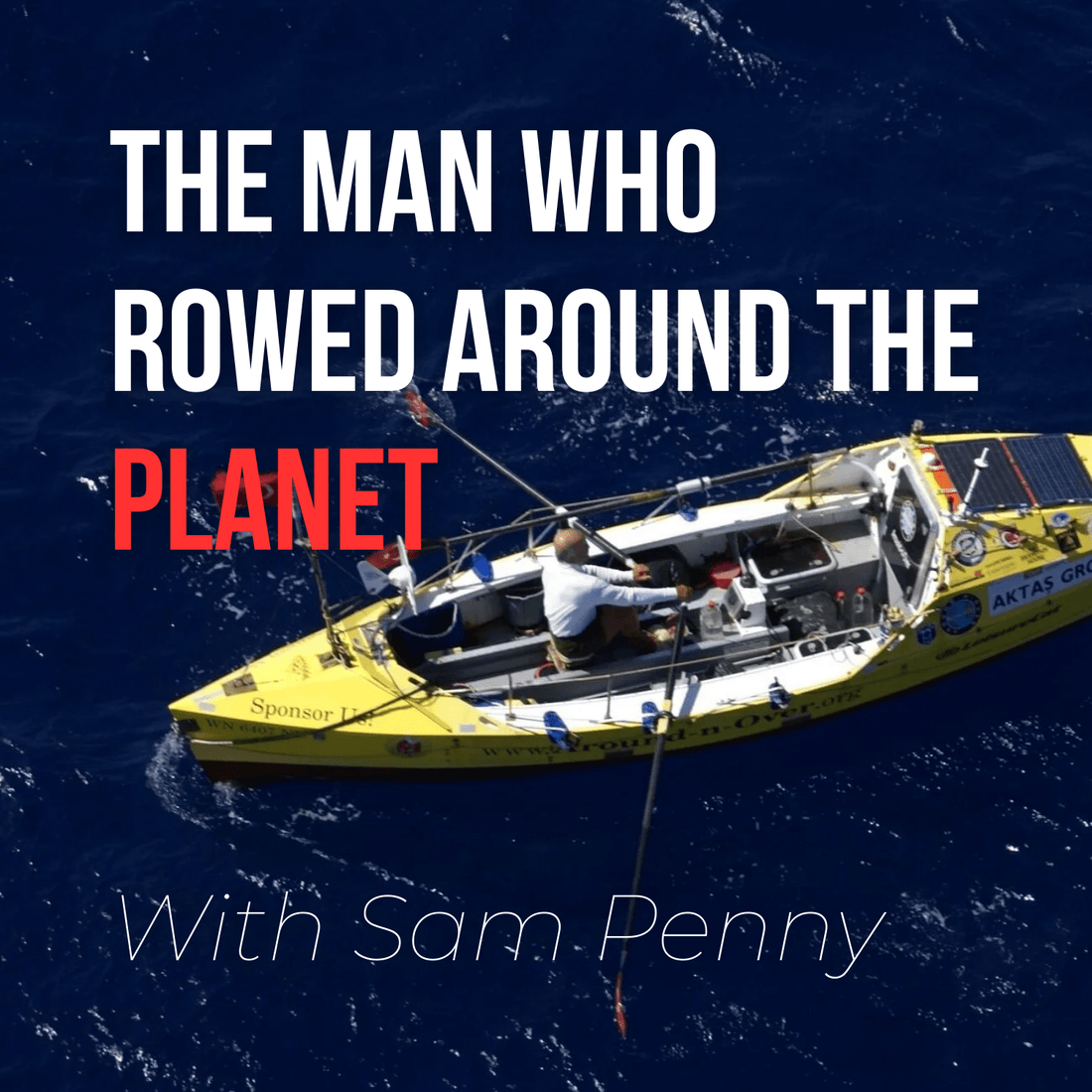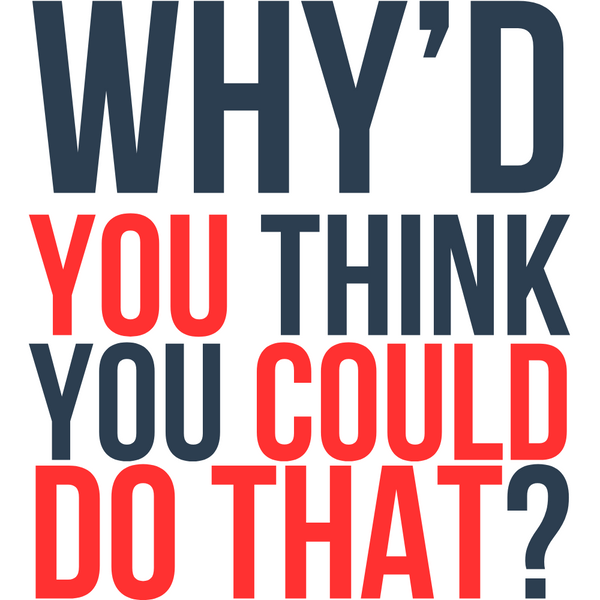
Rowing Into the Impossible: Erden Eruç’s Five-Year Human-Powered Circumnavigation
Share
He rowed across three oceans. Spent 312 days alone at sea. Climbed mountains and cycled across continents. Erden Eruç is the first person in history to circumnavigate the globe entirely by human power. This is not just a story of records — it’s a story of tragedy, grit, and lessons in courage that every one of us can carry into our lives.
In this episode of Why’d You Think You Could Do That?, I spoke with Erden Eruç, who holds 15 Guinness World Records and the distinction of being the first person to complete a solo human-powered circumnavigation of the Earth. Over five years, he rowed across the Pacific, Indian, and Atlantic Oceans, cycled thousands of kilometres across multiple continents, and even climbed mountains along the way.
His story is one of survival, routine, courage, and faith in the face of the impossible. And woven through his journey are lessons that can help us all navigate our own oceans — whether those oceans are personal, professional, or entirely unseen.
Contents
The Early Spark: Mountains and Curiosity
Erden’s childhood was filled with movement. Born in Cyprus, raised in Turkey, the son of a military officer, he grew up outdoors. His father introduced him to mountaineering when he was just eight years old, leading him up a volcano nearly 4,000 metres high. “That was the first summit of my life,” Erden told me. “I still remember looking out and feeling like the world was bigger than I had ever imagined.”
From then on, mountains and physical challenge were in his blood. He dreamed of flying, of climbing, even of becoming an astronaut. But as he got older, practicality took hold. He pursued mechanical engineering, earned multiple degrees, and eventually built a steady life in the United States. It was safe, it was respectable — but something was missing.
Lesson: Nurture the sparks of curiosity in your life. They may one day be the fire that carries you across impossible oceans.
Tragedy That Lit the Fuse
In 2002, while climbing with his friend and mentor, the renowned adventurer Goran Kropp, Erden witnessed tragedy. A fall took Kropp’s life. It was devastating — and it changed everything.
“Goran had once asked me: ‘When are you going to start your journey?’” Erden recalled. “After he died, I realised I couldn’t keep saying ‘one day.’ Life is fragile. I had to begin.”
That loss lit the fuse for his circumnavigation. The “what if” he once traced across a world map in his office became a commitment. He would row the oceans, cycle the continents, climb the peaks. He would honour his friend’s spirit by daring greatly himself.
Lesson: Sometimes loss is the fire that ignites purpose. Out of grief can come resolve.
First Attempts and Humbling Failures
In 2007, after ten years of planning, saving, and training, Erden finally launched from San Francisco in a custom-built seven-metre rowboat. Cameras rolled. Friends and sponsors cheered. And then the winds slammed him back into shore.
“It was humiliating,” Erden admitted. “I couldn’t even clear the Golden Gate. I had to be towed back. Everyone was watching.”
He could have quit. Instead, he regrouped, studied the tides, and relaunched from Bodega Bay. This time, he slipped into the open Pacific. The journey had begun. The first lesson was clear: failure is not final.
Lesson: Failures don’t disqualify us. They prepare us. Humiliation is often the first step on the road to greatness.
The Pacific: 312 Days Alone
Nothing can prepare a person for nearly a year alone at sea. “I didn’t see another human being for 312 days,” Erden said. “Just waves, sky, and the rhythm of my oars.”
His days were structured by routine. He rowed at sunrise, ate while pulling at the oars, and measured progress in miles per month, not hours per day. He aimed for about 1,000 miles each month. Nights were spent in a tiny cabin, trying to rest between storms, creaks, and the constant fear of rogue waves.
To fight loneliness and boredom, he gave his mind tasks. “Boredom can be more dangerous than fear. You have to give your mind a job,” he explained. He counted waves, sang to himself, wrote journals, and trained his mind to focus on small, manageable goals.
“Boredom can be more dangerous than fear. You have to give your mind a job, or it will eat you alive.” – Erden Eruç
Lesson: The way to survive overwhelming challenges is to break them down into daily routines. Structure is what carries us through chaos.
Darkest Moments: Circles in the Ocean
Nature doesn’t care about records. During a La Niña year, Erden spent weeks rowing in circles, trapped by equatorial winds. “I was losing ground every day,” he recalled. “My batteries failed. I ran out of food. I was soaked for months.” With only a week’s rations left, he finally accepted a tow from Filipino fishermen. “It felt like failure.”
But he continued. He reset, learned, and pushed forward. Again and again, he faced storms, doubts, and logistical nightmares. The darkest days weren’t just at sea. After finishing his circumnavigation, he fell into depression back on land. “You live as the adventurer for so long. Then you come home, and you’re just… ordinary again. That was harder than I expected.”
Lesson: Darkness doesn’t mean you’ve failed. It means you’re still human. Survival is choosing one more stroke, one more day, until light returns.
Lessons in Resilience and Grit
- Preparation beats panic: “Fear doesn’t go away. But when you’ve rehearsed every scenario, you know what to do.”
- Routine is power: Rituals and structure protect the mind when the environment is unpredictable.
- Failure is feedback: Every detour was a lesson. No wrong turn was wasted.
- Partnership matters: Though solo at sea, Erden credits his wife Nancy: “She held the line I couldn’t see.”
- Resilience is daily: The circumnavigation wasn’t achieved in one heroic burst. It was built one decision at a time.
Closing the Loop and Facing Home
After five years and 66,000 km, Erden returned to Bodega Bay — where he had launched. There was no parade, only a few friends waiting. He dipped his toe into the water and whispered: “The loop is closed.”
Yet the journey continues. He is now preparing for the 2026 Golden Globe Race, a non-stop solo sailing race around the world without modern tech. Another impossible challenge. Another chance to say yes.
Lesson: The end of one impossible journey is often the beginning of another. Growth never stops.
Why Did He Think He Could Do That?
Erden’s answer is simple: “Because if I didn’t try, I’d never know. Dreams are seeds. You have to protect them until they grow strong enough to stand.”
“Dreams are seeds. Protect them, water them, and they will grow strong enough to stand tall on their own.” – Erden Eruç
What We Can Learn
Most of us will never row across an ocean. But we all face challenges that feel endless and storms that threaten to sink us. Erden’s story reminds us that extraordinary things are built on ordinary persistence. Stroke by stroke. Day by day. That’s how the impossible becomes reality.
The lesson is not about superhuman strength. It’s about human courage — the choice to keep going when it would be easier to stop. And that is a choice we all face, no matter what oceans we row.
🎧 Listen & Connect
- 🌍 Erden’s Official Website: https://www.erdeneruc.com
- 📺 Erden’s YouTube: https://www.youtube.com/@erdeneruc3103
- 📘 Erden on Facebook: https://www.facebook.com/westboundrower
For more extraordinary stories of people who said yes to the impossible, subscribe to Why’d You Think You Could Do That? — the podcast where ordinary people do extraordinary things.
